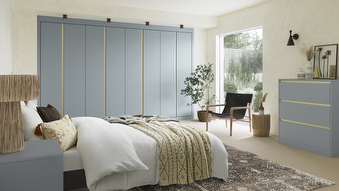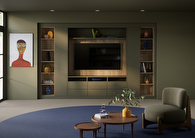
How to organise and declutter your home for the New Year
Set a precedent for the new year by decluttering your home using tips from our experts.


Do you feel restless instead of rested when trying to relax at home? The problem might lie in your home design. The wrong environment can make it hard to switch off or even directly spike our stress levels. Discover five home design ideas that will make your space a sanctuary for better day-to-day mental health. The secret lies in keeping your rooms calm, cool and clutter-free.
Well-lit rooms can help to boost productivity and reduce anxiety. This is because exposure to light – daylight in particular – triggers the brain to release serotonin, one of our happy hormones that makes us feel calm and focused.
Capitalise on these mood-boosting benefits by letting in the light as much as possible in your home, especially in spaces where you spend much of the day such as offices, kitchens and living rooms. Maximise natural light by keeping windows clear and framing them with thin fabric or blinds rather than curtains with a heavy weave. You can also add lamps to illuminate gloomy corners rather than relying on overhead lighting which can be harsh and cast unwanted shadows.
During winter when sunlight is in short supply, consider investing in a SAD lamp for your bedroom. These lamps simulate sunlight which encourages evening relaxation and morning motivation.
Quality sleep is an essential part of any healthy lifestyle plan, providing key physical and mental health benefits. A cool bedroom supports good sleep, especially when combined with excellent sleep hygiene such as avoiding screens and caffeine before bedtime.
Begin by literally cooling down the room. Thermoregulation is essential to falling and staying asleep because your body temperature naturally drops while you rest. The optimal temperature for a bedroom is between 15-19°C, so ensure your thermostat is set within this range. Breathable bedding will help to keep you cool while you sleep. Look for natural fabrics such as cotton and linen and temperature-regulating pillows.
Painting the walls in cool colours will further contribute to a restful night. Cool shades make us feel calm and are less stimulating than warm or bright hues. Several surveys cite blue as the best colour for the bedroom as its relation to sky and sea evokes a sense of serenity in mind and body.
Biophilic design – bringing the outdoors inside – is a recent wellness design trend that continues to thrive. It came about at the beginning of the decade when people were denied the mental nourishment of spending time outdoors. The concept is simple: if you can't be in nature, bring nature to you.
Introduce house plants into each room to infuse greenery into your interiors and purify the air in your home. Oxygenating and cleansing your space helps to reduce the amount of allergens, neutralise unpleasant odours and enhance the quality of your sleep and time at rest.
Nature-inspired décor will help to inspire similar feelings of ease. Prioritise greens, earth tones and muted hues that make up nature's colour palette. Pair this with cushions and curtains in pretty floral patterns and furniture made using natural materials like wood.
Find ways to blend indoor and outdoor in your living spaces too. For example, add a conservatory that bridges the house and garden and acts as a suntrap with soothing, year-round views. You should also make use of garden furniture in the summer for working and unwinding in the fresh air.
The most important step in redesigning your home to improve mental wellbeing is to remove clutter. Prolonged exposure to untidy environments can make us anxious and overwhelmed. This is because clutter represents unfinished tasks, and being surrounded by situations that the mind deems incomplete can trigger a stress response.
Start by sorting through your belongings, identifying essentials and sorting old or unused items into separate piles for donation, recycling and waste. Scale back your things as much as possible, look for unnecessary hoarding, and ensure that everything you keep brings you joy.
Next, invest in creative storage solutions to organise busy areas. For example, customisable understairs storage from Hammonds, with elements like shelving and pull-out shoe racks, can transform a chaotic hallway into an entrance that inspires calm.
Swapping bulky furniture like traditional cabinets for sleeker pieces that take up less space will also make rooms feel less cluttered. Multi-purpose pieces such as coffee tables with built-in drawers are a great way to increase your storage options while keeping a clear floorspace.
Creating an environment that supports your mental health is essential if you want your home to be a sanctuary. For assistance with ideas, book a free design visit with our team for specialist advice tailored to your home and individual needs. Discuss fitted furniture, storage solutions and all things interior design.

Set a precedent for the new year by decluttering your home using tips from our experts.

Inspired by nature and rooted in calm, grounding tones, the earthy living room trend is all about bringing the warmth and serenity of the outdoors into your living space.

Living rooms can be hard to get right. They're often busy family rooms where children play, dogs sleep and the grown-ups take a moment with a cup of tea.
Whether you have an exact vision in tow, or are just at the beginning stage of your home renovation, we have heaps of inspiration for you to get stuck into.
Find a wealth of design tips, trends and inspiration in the pages of our brochure, magazine and on our blog. Our experts are always ready to help you create dream home, pop in store or book your free design visit for experts to help on bringing your vision to life.